 Storm clouds were brewing over the Black River on Saturday morning, but we decided to paddle it anyway.
Storm clouds were brewing over the Black River on Saturday morning, but we decided to paddle it anyway.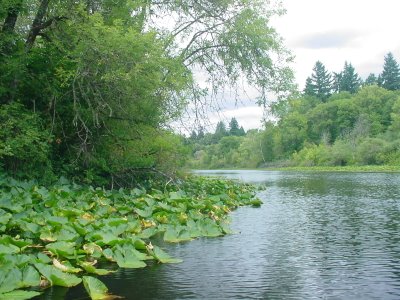 This is a meandering, tranquil river southwest of Olympia, with tannins from rotting vegetation that cause the river to look black. It is spooky in the winter, reminding me of the atmosphere in 'The Hobbit' or 'Willow'. It curls around the southeastern base of the Black Hills below Capitol Forest, and although it has excellent access, it is considered to be one of the most remote rivers in the state.
This is a meandering, tranquil river southwest of Olympia, with tannins from rotting vegetation that cause the river to look black. It is spooky in the winter, reminding me of the atmosphere in 'The Hobbit' or 'Willow'. It curls around the southeastern base of the Black Hills below Capitol Forest, and although it has excellent access, it is considered to be one of the most remote rivers in the state.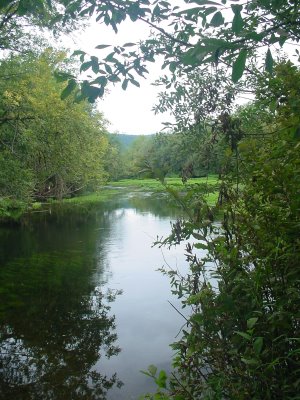 The Black River is simply idyllic in the summertime, with songbirds, butterflys and hooting owls. It is protected by marshes and pasturelands, both public and private, and barely flows for the first 5 miles of a 12 mile segment. It was carved by the massive glacial melt in the Cascades at the end of the last ice age.
The Black River is simply idyllic in the summertime, with songbirds, butterflys and hooting owls. It is protected by marshes and pasturelands, both public and private, and barely flows for the first 5 miles of a 12 mile segment. It was carved by the massive glacial melt in the Cascades at the end of the last ice age. We paddled upstream during the height of mid-day, along miles of lily pads that were curling in the sun, drying up. You know that a river is shallow when these pads grace the shoreline - they have long submerged stems that are 3 - 4 feet tall, allowing the leaves to float on top. More shallow areas invite different types, with altogether different flower and blooms.
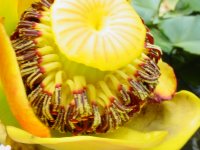 I photographed a few of the brilliant yellow cow-lilies that are turning color right now. The waxy, cup-shaped flowers have stamens that are particularly colorful, a reddish maroon. These lilies open in the morning and close in the afternoon.
I photographed a few of the brilliant yellow cow-lilies that are turning color right now. The waxy, cup-shaped flowers have stamens that are particularly colorful, a reddish maroon. These lilies open in the morning and close in the afternoon. 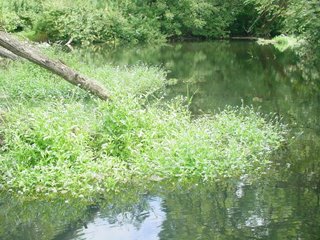 Outbursts of crowfoot, wild mint, and forget-me-nots covered sub- merged, rotted logs, and snags blocked passages. We had to paddle around them, and in some cases had to lay flat in the canoe in order to get under them.
Outbursts of crowfoot, wild mint, and forget-me-nots covered sub- merged, rotted logs, and snags blocked passages. We had to paddle around them, and in some cases had to lay flat in the canoe in order to get under them.We found a little side-branch to the Black River, like a small lake, and we explored that down to the very endwhere there was a gravelbar. There, on the shoreline, a trail entered an oak grove, and then a vast field of dry grass, with mima mounds for as far as the eye could see. We were impressed, as it was such a difference from the dense forest that we'd just paddled through.
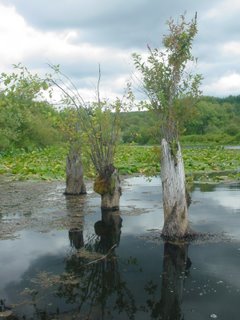 As we headed back through old pilings, we came across large gelatinous egg sacks attached to tree limbs under the water. (I couldn't film them.) They were over 24 inches in diameter, and I lifted one up, to look at all the large eggs inside. I haven't done the research yet on what type of salamander layed these eggs sacks - we came upon about 12 of them - they are new to us. In all our years of canoeing, we've never seen such large ones.
As we headed back through old pilings, we came across large gelatinous egg sacks attached to tree limbs under the water. (I couldn't film them.) They were over 24 inches in diameter, and I lifted one up, to look at all the large eggs inside. I haven't done the research yet on what type of salamander layed these eggs sacks - we came upon about 12 of them - they are new to us. In all our years of canoeing, we've never seen such large ones.As remote as these waters can be, someone has 'managed them'. We noticed large nesting bins on the sides of trees, probably for owls, and smaller bird-houses on old posts right out in the water. We paddled up to one of these, and I looked inside the entrance.
 It was covered in tiny feathers and grass, and had been aban- doned long ago.
It was covered in tiny feathers and grass, and had been aban- doned long ago. While George explored the mima mounds, I video- taped the work-crew of a huge ant hill. Up close, the film came out quite good. It made all of these little workers so admirable, as they worked together to build and maintain their nest.
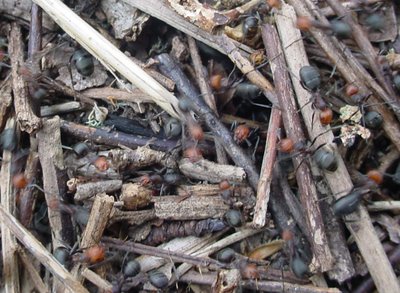 It was under a pine tree, and was about 3 feet tall, with about 20 entrances.
It was under a pine tree, and was about 3 feet tall, with about 20 entrances.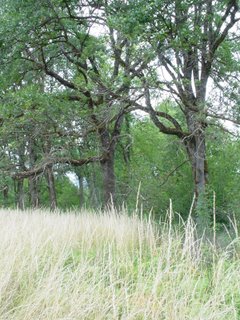 I also filmed the mima mounds, the oaktrees, and the pathway through the woods. I enjoy having videos of our hikes and paddles, and I play them as I cook in my kitchen. During the week, as we sit with dinner, we discuss the paddle and what we've learned from it.
I also filmed the mima mounds, the oaktrees, and the pathway through the woods. I enjoy having videos of our hikes and paddles, and I play them as I cook in my kitchen. During the week, as we sit with dinner, we discuss the paddle and what we've learned from it. There was an especially dangerous section where the water looked only about a foot deep, with about 5 feet of brown sediment creating the bottom. This is not a place to get out of the canoe! George put his paddle down into the water, and it went down the entire length of the paddle - that can be like quicksand, a sediment bog, and one cannot swim out of it. I was very eager to get out of there.
On this paddle, George took us further upriver than we'd planned, and we didn't pack any food. Fortunately, I carry a double-shot Starbucks espresso and a few granola bars in my camera case, and that saved the day. Notice in this last shot, that we weren't alone. We met two other paddlers, none of whom ventured as far upriver as we had.
